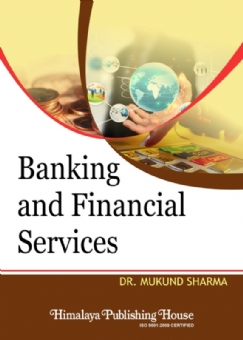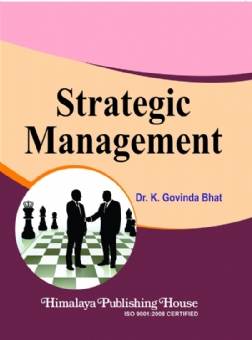This sixth edition of the book covers all significant and recent areas of Personal and Human Resource Management.
Distinctive Features of the Book :
– Learner-Friendly Approach;
– Wide and Comprehensive Coverage;
– Integrated presentation of the text with boxes, figure, exhibits and tables;
– Numerous examples;
– Presents Cases and Games;
– Customised and lucid language.
Contents :
1. Nature and Scope of Human Resource Management –
Introduction, Differences Between HRM and SHRM, Functions of HRM, Nature of Human Resources, Scope of Human Resources Management, Importance of Human Resources Management, Role of Human Resources Management, Systems Approach to Study HRM, Objectives of Human Resources Management, Who Performs HRM Functions?, Role of Human Resources Manager, Qualifications and Qualities of Human Resource Manager, Evolution and Development of HRM, Recent Developments, Questions for Discussion
2. Human Resource Management: Environment and Strategies –
Business Environmental Factors, Human Resource Management Environment, Impact of Environment on HRM, Strategic Human Resource Management, Introduction, What is Strategy?, What is Strategic Management?, Strategic Management Process, Corporate Level Strategies, Strategic Human Resource Issues, Organisational and Human Resource Strategies, SBU Level Strategies, References, Questions for Discussion
3. Job Analysis, Team Analysis and Flexible Job Environment –
Job Design, Job Redesign, Job Description, Job Specification, Benefits or Uses of Job Analysis, Team Design, Job Sharing, Telecommuting, Ergonomics, Employee Empowerment, Questions for Discussion
4. Human Resources Planning –
Strategic Planning – Basis for Human Resources Planning, Meaning and Objectives of Human Resources Planning, Benefits of Human Resources Planning, Factors Affecting Human Resource Plan, Process of Human Resources Planning, Problems in Human Resources Planning, Recent Implications, Recent Trends in HRP, Conclusion, Questions for Discussion
5. Recruitment –
Definitions and Objectives, Strategic Management and Recruitment, Search for Prospective Employees/Sources of Recruitment, Stimulate the Candidates to Apply for a Job, Alternatives to Recruitment, Applicants’ Pool, Assessment of Recruitment Programme, Questions for Discussion
6. Selection, Placement and Induction –
Meaning and Definition, Selection Procedure, Placement, Induction, Recent Trends in Selection, Questions for Discussion
7. Human Resource Development –
Significance of Human Resource Development, The Concept of Human Resources Development (HRD), Scope of HRD, Need for HRD, HRD Objectives, Human Resources Development Framework, The Functions of HRD Managers, Attributes of an HRD Manager, Questions for Discussion
8. Performance Appraisal and Management –
Introduction, Strategic Management and Performance Appraisal, Meaning, Need and Purposes, Appraisers, Methods of Performance Appraisal, Modern Methods, Results Method, Managerial Appraisal, Uses of Performance Appraisal, Problems of Performance Appraisal, Questions for Discussion
9. Employee Training –
Strategic Training, Assessment of Training Needs, Training Methods, The Training Procedure, Training within The Industry, Advantages of Training, Evaluation of Training Programme, Recent Developments in Training, Special Aspects of Training, Team Training, Questions for Discussion
10. Management Development –
Introduction, Contemporary Areas of Management Development, Methods of Management Development, Training and Development for International Assignments, Questions for Discussion
11. Career Planning and Development –
Career Planning, Succession Planning, Career Development, Questions for Discussion
12. Promotion, Transfer and Demotion –
Promotions, Transfer, Demotions, Questions for Discussion
13. Absenteeism and Labour Turnover –
Absenteeism, Labour Turnover, Questions for Discussion
14. Management of Change and Development –
Technology and HRD, Technology Change with Human Face, Managing Change, Resistance to Change, Approaches to Organisational Change, Organisation Development, Questions for Discussion
15. Job Evaluation –
Introduction, Meaning/Definitions of Job Evaluation, Job Evaluation Methods/Techniques, Problems of Job Evaluation, Merit Rating, Questions for Discussion
16. Wage and Salary Administration –
Definitions and Concepts, Objectives of Wage and Salary Administration, Factors Affecting Wage/Salary Levels, Wage Boards and Pay Commissions, Wage Incentives, Bonus, Managerial Compensation, Questions for Discussion
17. Social Security and Welfare –
Social Security, Need for Extending Social Security and Welfare Programmes, Types of Social Security and Welfare Programmes, Non-Monetary Rewards, Questions for Discussion
18. Motivation and Job Satisfaction –
Definitions, Theories of Motivation, Job Satisfaction, Questions for Discussion
19. Morale –
Definition, Factors Affecting Morale, Measurement of Morale, Improvement of Morale, Questions for Discussion
20. Communication –
Introduction, Management Information System (MIS) and Information Technology, Oral, Written and Non-Verbal Communication, Communication Channel and Network, Interpersonal Communication, Listening, Organisational Communication, Informal Communication or Grapevine, Barriers to Communication, External Barriers, References, Questions for Discussion
21. Leadership –
Leadership, Leadership Theories, Leadership Styles, Qualities/Approaches of Outstanding Leaders, Leadership Skills, References, Questions for Discussion
22. Work Environment, Industrial Accidents, Safety and Health –
Introduction, Fatigue, Monotony, Boredom, Industrial Accidents, Employee Safety and Industrial Health, Employee Safety, Industrial Health, Questions for Discussion
23. Indian Labour Market –
Meaning, Salient Features of Indian Labour Market, Organised and Unorganised Labour Markets in India , Bonded Labour, Child Labour, Questions for Discussion
24. Industrial Relations –
Meaning, Code of Industrial Relations, Conditions for Congenial Industrial Relations, Questions for Discussion
25. Trade Unions and Employers’ Associations –
Trade Unions, Functions and Role of Trade Unions, Objectives of Important Indian Trade Unions, Union Structure, Problems of Trade Unions, Why Decline in Trade Unions After Globalisation?, Measures to Strengthen Trade Union Movement in India, Employers’ Organisations, Questions for Discussion
26. Grievance, Discipline, Counselling and Mentoring –
Grievance Procedure, Disciplinary Procedure, Employee Counselling, Mentoring, Questions for Discussion
27. Collective Bargaining –
Definition of Collective Bargaining, Conditions for The Success of Collective Bargaining, Collective Bargaining in India, Questions for Discussion
28. Industrial Conflicts –
Definition of a Dispute/Conflict, Causes of Industrial Conflicts, Types of Industrial Conflicts, Prevention of Industrial Conflicts, Settlement of Conflicts, Questions for Discussion
29. Participative Management, Quality Circles, Empowerment and Engagement –
Co-Determination, Autonomous Work Groups, Industrial Democracy, Socio-technical Systems, Suggestion Scheme, Workers’ Participation In Management (WPM), Quality Circles, Empowerment, Employee Engagement, References, Questions for Discussion
30. Quality of Work Life and Related Issues –
Introduction, Quality of Work Life, Workplace Violence, Sexual Harassment, Alcoholism and Drug Abuse, Questions for Discussion
31. Total Quality and Human Resource Management –
Meaning and Definition, Human Resource Development and TQM, The Total Quality Human Resources Strategy, Questions for Discussion
32. Human Resource Records, Accounting, Audit and Research –
Human Resource Records, Human Resource Accounting, Human Resource Audit, Human Resource Research, Questions for Discussion
33. Contemporary Issues in HRM –
Employer’s Brand, What Constitutes an Employer Brand?, Competency Mapping, Business Process Outsourcing: HR Issues, HR and Balanced Scorecard, Human Resource Matrix Management, Dual Career Groups, Knowledge Management, Virtual Organisation and HRM, Learning Organisations, Rightsizing of Workforce, Emotional Intelligence (EI), Talent Management, Diversity Management, Work-Life Balance, Whistle-Blowing Policy, HR Six Sigma Process, Human Resource Analytics, References, Questions for Discussion
34. Ethics in Human Resource Management –
Meaning of Ethics, Ethics in Job Design, Human Resource Planning, Recruitment and Selection, Training and Development, Career Planning and Development, Employee Turnover, Wage and Salary Administration, Questions for Discussion
35. International Human Resource Management –
Introduction, Global Recruitment, Global Selection Process, Expatriates, Performance Appraisal, Training and Development, Compensation and Benefits, International Industrial Relations and Trade Unions, References, Questions for Discussion
36. E-Human Resource Management –
Introduction, E-Business, Neural Networks, E-Job Design and Job Analysis, E-Human
Resource Planning, E-Recruitment, E-Selection, E-Performance Management, E-Training and Development, E-Compensation Management, E-HR Records, E-HR Information, E-HR Audit, Questions for Discussion
Appendix – I Method of Case Analysis –
What is a Case?, How to Analyse a Case?
Appendix – II Cases –
(1) Low Salary for Nationals and High Salary for Expatriates for the Same Job = Halting the Wings of the Flights (2) Telecommuting: Empty Cubicles vs. Beyond Job Design? (3) Downsize or Upsize: Compliance to Strategy or Adjust the Strategy? (4) Decide Now, But Do it Tomorrow! (5) Treating the Employees as Human Beings and Cost on HR as Strategic Investment? (6) An Ethical Dilemma (7) Collective Bargaining vs. Individual Bargaining (8) Do You Redress the Grievances of Employee’s Wife Too?
Subject Index







